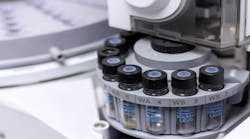Ethan Smith, General Manager, Life Sciences, Nuvolo
The world has progressed into a digital age, and it’s time for the pharma industry to catch up.While plant floor equipment has benefited from automation, many of the processes that surround manufacturing remain paper-based.
Pharma Manufacturing recently spoke with Ethan Smith, general manager, Life Sciences at Nuvolo about how furthering pharma’s digitalization journey can help the industry reap big benefits in quality and manufacturing.
Q: How is digitalization impacting pharma manufacturing?
A: Digitalization is massive for pharma across the board. This industry — and particularly manufacturing — has operated off documents (aka paper) for most of its existence. Regulators and inspectors from health authorities have historically asked to see and review documents during inspections. Employees are trained using documents. And information has been ‘stored’ — if you can call it that — in documents over the years.
Now, advances in cloud technology, the IoT movement, and new platforms offering enhanced integration capabilities are all driving the pharma industry and its manufacturing towards digitalization.
People now expect digital solutions at home and at work. From banking to getting groceries delivered, everything is happening digitally — and pharma manufacturing really needs to catch up with that overall trend.
Q: What is the ultimate goal of digitalization in the pharma industry?
A: Ultimately the pharma industry is here to deliver safe and effective therapies to patients. The goal of digitalization is to make that process simpler, faster and more secure.
That said, it’s also important to recognize that digitalization is a journey, not a destination. There’s no singular goal or solution that we can deploy and say we are done. It’s a constant evolution, and I think we all know that technology waits for no one. These advances are going to continue to accelerate.
Q: Where are there still inefficiencies in the manufacturing process?
A: Pharma manufacturing execution — the actual running of the equipment to make the products — is all highly efficient.
However, what happens before and after production can be improved. Determining how much of a therapy to make is one thing that hinges on market demand. But once that’s decided, other factors come into play, like shelf life, manufacturing capacity, and the availability of equipment, ingredients and intermediaries. This requires lots of manual effort.
Downstream, quality review is also a highly manual process that could benefit from digitalization. It can take months for a manufactured batch to be cleared through quarantine due to paperwork. However, if documentation is digitalized, that timeline can shrink, allowing therapies to hit the market sooner. This can prevent drug shortages and positively impact company revenue.
Q: What solutions can help address these inefficiencies?
A: Solutions to these kinds of complex challenges must be flexible, interoperable and most importantly, highly reliable to operate in the manufacturing space.
At Nuvolo, we aim to work within the landscape of the existing mission critical applications that support manufacturing, like manufacturing execution systems and quality management systems.
For example, in order to release a batch, the quality department needs to know that all of the equipment used to manufacture that specific batch on that specific date was: up-to-date on all of its planned maintenance; calibrated within an acceptable tolerance; and properly cleaned and set-up for the process. All of this information can be found in our GxP Asset Management product.
With the batch number and the product information from the MES or ERP system, we’re able to provide the quality department with a validated report that documents that all of the equipment used was in fact ‘ready for use’ for manufacturing. Think of it as a green light status at the asset level.
It might sound relatively simple on the surface that, yes, this machine was ready to work when the batch was manufactured. But when lots of batches are being produced across multiple sites around the world that have multiple manufacturing lines within them, there can be hundreds of thousands of pieces of equipment involved.
Nuvolo allows for the quality department to get the same level of output without having to verify each piece of equipment by going line by line through that executed batch record individually. Instead, it’s sourced as a digital record to supplement the quality review package.
Q: What does the term ‘digital alignment’ mean?
A: Simply put, digital alignment is bringing together processes and data to make them operate more efficiently.
Technology platforms promote digital alignment because they inherently bring processes and information together since the information and processes coexist on the same platform. This is why we’re seeing more larger pharma companies adopting an IT strategy centered around enterprise platforms.
Q: What are some of the long-term benefits of digitally aligning quality and manufacturing?
A: Bringing quality and manufacturing into closer alignment has three crucial benefits.
The first one is providing equipment information from a manufactured batch to the quality team to streamline the batch review process. This saves time while maintaining — arguably enhancing — the level of quality and allows the quality team to focus on what they do best and what matters most: ensuring that all the process steps were followed.
The second critical benefit is that tracking batch numbers and products that each piece of equipment has produced creates new information and insights for the manufacturing function that owns these pieces of equipment. By including those batch numbers in the compliant audit trail of every asset, the manufacturing team can analyze the equipment’s performance based on their company’s products. This is an entirely new dimension for asset management, which has historically been managed just with downtime and runtime metrics. These new insights will help manufacturing teams as well as finance and procurement to make better decisions around when to repair, replace or supplement a device for manufacturing efficiency.
Thirdly, digital alignment of quality and manufacturing will prevent production delays by enabling the reservation of all the equipment that is needed for a production run in a single place where the maintenance plans and records for the equipment are also maintained. This ensures that a manufacturing site doesn’t get ready to start a batch only to find out that one piece of equipment has an open maintenance order or is out of calibration and then those challenges turn into costly production delays.
Q: Are there opportunities to mature this alignment even further in the future?
A: Absolutely. It’s definitely a journey and the companies involved in it — both pharma manufacturers as well as technology providers like Nuvolo — are going to continue to evolve and mature processes and solutions to the challenges that have existed in the industry for quite a while.
For Nuvolo specifically, we see maturing the employment of machine learning and advanced analytics using that data as the way to enable true asset performance management. For example, does one piece of equipment like a tablet press perform better when a manufacturer is making one of its products versus another product? Are there ways that manufacturers can use equipment better? Pharma requires very expensive assets to produce its products, so if companies can focus on product intelligence it will change the way the equipment is managed, maintained and ultimately purchased.
The advancement of cell and gene therapy and other personalized areas of medicine where a single patient is the actual batch is also on the horizon. Digital alignment will help improve yields and timelines, getting a patient’s personalized therapy back to them as efficiently as possible. The clock is ticking for the patient, so being able to be more productive and more efficient here is massive.
At Nuvolo, we are excited to have some involvement in that by working with the industry to help find areas where we can continue to evolve and expand, as well as discover entirely new ways to further help the industry and patients.

